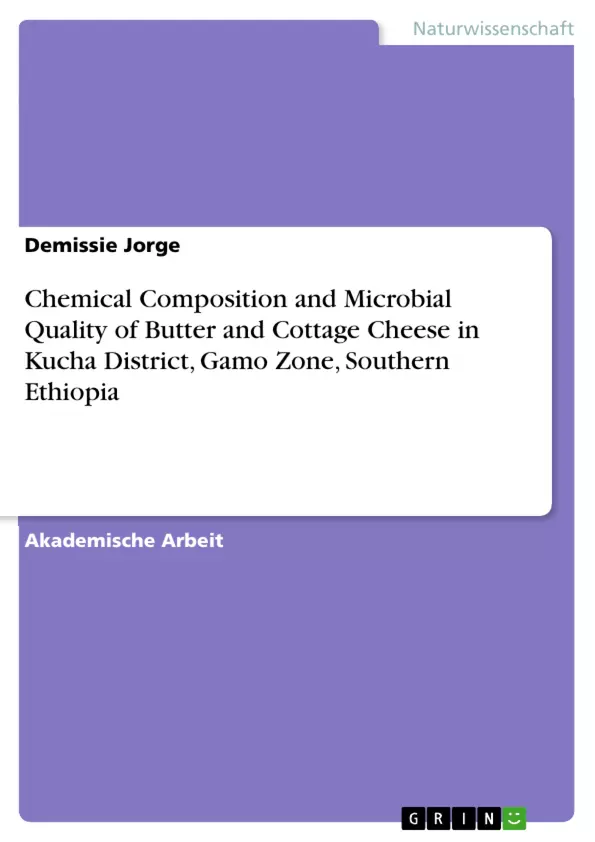The study was conducted in Kucha district of Gamo zone southern Ethiopia to evaluate chemical composition and microbial quality of butter and cottage cheese collected from small holder farmers. One hundred twenty grams (120g) of each fresh butter and cottage cheese samples were aseptically collected from smallholder farmers using sterile container for chemical composition and microbial quality analysis. Each parameter was analyzed in duplicates following standard laboratory procedures and the average value was taken to avoid false positive results.
Milk produced in different parts of the country under traditional production systems is either consumed directly or processed into various traditionally produced more shelf stable dairy products mainly naturally fermented milk (ergo), soured skimmed milk (arera), butter (kibe) and cottage cheese (ayib). The average values of total solids, fat and ash contents of butter produced in rural farmers in southern Ethiopia were 85.84±1.02, 81.53±1.00 and 0.16±0.004, respectively and also 17.2% moisture, 1.3% protein, 0.1% carbohydrate, 0.024% calcium and 0.0015% iron.
Inhaltsverzeichnis
- ABSTRACT
- INTRODUCTION
- MATERIALS AND METHODS
- Sampling
- Chemical composition analysis of butter and cheese samples
- Microbiological quality analysis of butter and cheese samples
- Total Bacteria Count
- Coliforms Count
- Enterobacteriaceae count
- Bacterial species identification
- Data Analysis
- RESULTS AND DISCUSSION
- Chemical Composition of Butter and Cottage Cheese
- Chemical composition of butter
- Relationship between butter chemical composition variables
- Chemical composition of cottage cheese samples
- Relationship between cheese chemical composition variables
- Microbiological Quality of Butter and Cheese
- Microbiological quality of butter
- Microbial quality of cheese
- Bacteria isolates from butter samples
- Bacterial isolates from cheese samples
- Chemical Composition of Butter and Cottage Cheese
- Bewertung der chemischen Zusammensetzung von Butter und Hüttenkäse aus verschiedenen Agrarökologien
- Bewertung der mikrobiellen Qualität von Butter und Hüttenkäse, einschließlich der Identifizierung der dominierenden Bakterienarten
- Untersuchung des Einflusses von Agrarökologien und Verarbeitungspraktiken auf die Qualität der Milchprodukte
- Entwicklung von Empfehlungen zur Verbesserung der Hygiene und der Handhabungspraktiken in der Milchproduktion und -verarbeitung
Zielsetzung und Themenschwerpunkte
Diese Studie wurde im Bezirk Kucha der Gamo-Zone in Südethiopien durchgeführt, um die chemische Zusammensetzung und die mikrobielle Qualität von Butter und Hüttenkäse zu untersuchen, die von Kleinbauern gewonnen werden. Die Ergebnisse der Studie liefern wichtige Erkenntnisse über die Qualität von Milchprodukten in der Region und unterstreichen die Notwendigkeit, die Milchproduktion und die Handhabungstechniken zu verbessern, um die Qualität der Produkte zu gewährleisten.
Zusammenfassung der Kapitel
Die Studie untersuchte die chemische Zusammensetzung von Butter und Hüttenkäse, wobei signifikante Unterschiede zwischen den Agrarökologien festgestellt wurden. Sowohl Butter als auch Hüttenkäse wiesen signifikant höhere Gesamtkeimzahlen, Enterobakterien- und Koliforme-Zahlen auf als die für die Qualitätsstandards akzeptablen Grenzwerte, was auf unzureichende hygienische Bedingungen während der Milchverarbeitung und -handhabung hindeutet.
Die Untersuchung der mikrobiellen Qualität ergab das Vorkommen verschiedener bakterieller Pathogene in beiden Milchprodukten, wobei das Vorkommen jedoch je nach Agrarökologie und Probenart variierte. Die Studie identifizierte wichtige Bakterienarten, die die Milchprodukte kontaminieren, darunter Escherichia coli, Salmonella-Arten, Enterococcus faecalis, Enterobacter aurugenosa, Staphylococcus aureus, Shigella-Arten und Klebsiella-Arten.
Schlüsselwörter
Butter, Hüttenkäse, chemische Zusammensetzung, mikrobielle Qualität, Agrarökologie, Escherichia coli, Salmonella, Enterococcus faecalis, Enterobacter aurugenosa, Staphylococcus aureus, Shigella, Klebsiella
- Quote paper
- Demissie Jorge (Author), 2019, Chemical Composition and Microbial Quality of Butter and Cottage Cheese in Kucha District, Gamo Zone, Southern Ethiopia, Munich, GRIN Verlag, https://www.grin.com/document/1164427



